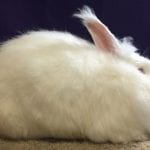Scientific Facts
| Common Name: | Flemish Giant Rabbit |
| Scientific Name: | Oryctolagus Cuniculus Domesticus |
| Life Span: | 8 to 10 years |
| Size (Adult): | Up to 2.5 feet long |
| Weight (Adult) | Up to 22 pounds |
| Body Shape: | Mandolin Shape |
| Habitat: | Grassy fields and forest |
| Country of Origin: | Belgium |
Physical Description
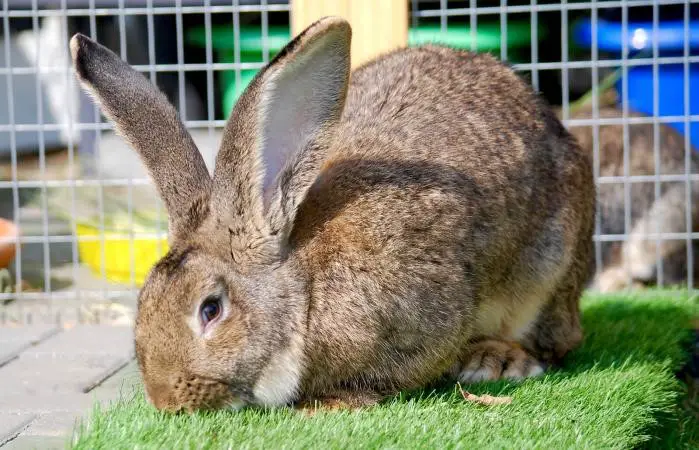
The Flemish Giant Rabbit is one of the largest breeds of rabbits cared for domestically. They are a semi-arch type of rabbit with their back arch starting right behind their shoulders, continuing down the base of their tail. As such, it gives off that “mandolin” shape.
Their bodies are powerful and long, with broad hindquarters. Their fur are known to be dense and glossy. When these rabbits are stroked from their hindquarters up to the head, the fur rolls back to their original position, which is an interesting feature of these rabbits.
Fast Facts
Here are some of the fast facts about the Flemish Giant Rabbit:
Best Suited For: house rabbits, rabbits for singles, first-time rabbit owners, families with children, indoor and outdoor enclosures
Temperament: sweet, docile, friendly
Comparable Breeds: Giant Angora Rabbit, French Lop
Colors
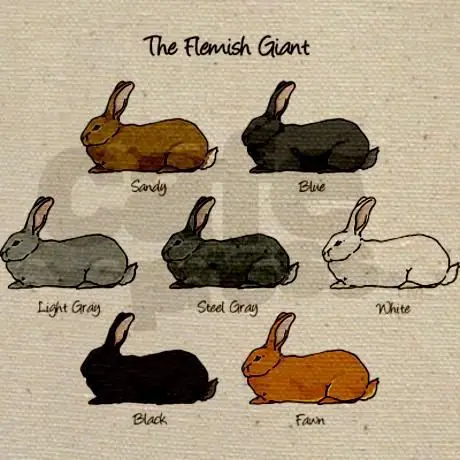
According to the American Rabbit Breed Association (ARBA), there are seven different colors of Flemish Giant Rabbits available: blue, black, sandy, fawn, steel gray, light gray, and white. Back in 1916, only blacks, steels and light grays were recognized. In 1919, whites and blues were accepted, in 1924, Sandy, and Fawn in 1938.
Lifestyle and Behavior
Flemish Giant Rabbits are docile creatures which are tolerant of human handling them. This, however, can only be achieved with frequent interaction. Just like all other varieties of rabbits, Flemish Giant Rabbits can become fearful, even aggressive at times, especially when handled irresponsibility and incorrectly.
The larger body frame of these rabbits need special attention to their spine when handling. Also, because of their size, these rabbits requires enough space for their living quarters, giving them ample opportunity for movement and actions.
It is recommended to keep rabbits inside a spacious home. As explained by the United States Department of Agriculture, the standard for animal housing for rabbits (especially ones that are over 12 pounds), should be at least 5 square feet of floor space. It also goes to say that the size of their home should also increase along with their growth.
Cages that uses incorrectly sized wire gauge bottoms may result to harming a Flemish Giant Rabbit in the same way that it can also harm them if they live in a smaller house that they have outgrown. As a recommendation for their house, a resting board may be needed in order to prevent the occurrence of sore hocks.
Habitat
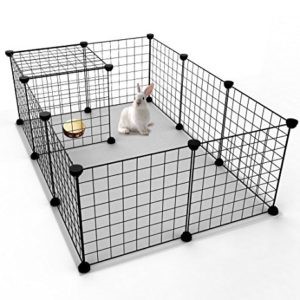
When Flemish Giant Rabbits are cared for as domestic pets, a regulated environment is very important in order to protect them against hypothermia or heat exhaustion. This is not a problem among wild rabbits because they can make their homes despite the extremes in temperature. On the other hand, things may be different with domesticated Flemish Giant Rabbits. They are wired to receive a different kind of abode, allowing them to thrive in terms of health.
One of the challenges that you may end up facing when taking care of a Flemish Giant is giving it enough space for its home. They usually do not fit in standard cages for rabbits, as they can be too cramped for them. Rather, you may want to prepare a large dog crate, especially if you are planning to care for your rabbit indoors.
For outdoor kept rabbits, you also need an enclosed, safe space which is big enough for them to move around comfortably. Remember that your rabbit will also need plenty of movement and exercise. Other owners recommend attaching a playpen to a crate so as to allow your rabbit to explore indoors. You may also want to prepare an entire room just for your rabbit.
An outdoor rabbit will also love a dog kernel, provided that the upper part is enclosed so that the giant rabbits is protected from bird predators. The most important thing is to prepare a house or a playpen for your pets that allow them to stretch out without any of their body parts touching the walls from end to end, or side to side.
Social Habits
Flemish Giant Rabbits are highly social creatures. This is why they usually live in larger groups often called as colonies. Dusk and down are considered as the busiest time of their day, as this is when they usually go out to find their food. The low light enables them to hide from predators.
This could be different in a domesticated setting. For one, it depends how many rabbits you have. They love being with friends. However, if you prefer having just a few of them, these rabbits usually end up seeking for your attention and playing with you.
Eating Habits
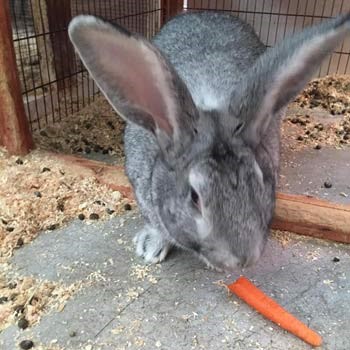
Needless to say, Flemish Giant Rabbits need larger food quantities for their meal compared to smaller breeds of domestic rabbits. The Flemish Giants can be fed just like other rabbit species. Aside from their regular food, they may also be fed with hay, as well as other occasional treats.
In order for your rabbits to gain bone mass while growing, a high protein diet of about 15% is needed. This will also be used by their body as muscle mass starts to develop. Cabbage, apples or broccoli in smaller quantities can also be given as treats, increasing slowly as time passes by.
A quarter apple a day per rabbit every other day for a period of three weeks can also be increased to having half an apple after. Avoid feeding your rabbit with seeds or fruit core. Since these rabbits do not reach their full size until reaching one and a half year old, it is important to feed them a lot. Pregnant Flemish Giant Rabbits also need to be fed more, as well as during winter, and given plenty of water.
When supplementing a natural diet with a commercial meal, it is very important to be careful not exceeding their intake of calories, protein and minerals including calcium and salt. Excess of these minerals may result to the presence of kidney stones in their body. Overfeeding, on the other hand, can also lead to obesity, which is often considered as a major health issue for both pet and commercial rabbits.
A house Flemish Giant Rabbit is recommended to consume 2 cups of chopped leafy vegetables for every 3 kg (6 pounds) of body weight. It should also be no more than 2 tablespoons of carrots or fruits for every 3 kg of body weight every day.
Just like all other animals, all rabbits, including Flemish Giant Rabbits need a clean and fresh supply of water. Make sure to offer their rabbit safe treats in moderation, including fruits and veggies.
Grooming
Just like other rabbits breeds with short hair, these rabbits need minimum attention to grooming, thanks to their shorter hair. They only need minor grooming weekly in order to make sure that their coat stays in good shape. Brush at least once a week using a slicker brush. If you notice that they are molting, then you can brush twice a week to keep them in top shape.
These rabbits usually shed their coat twice a year. The first one happens in the spring, and the second one in the fall. The exact schedule of shedding may also vary from one rabbit to another. The tips of the rabbits toenails should be occasionally trimmed unless they get enough exercise that will naturally wear them down.
Spaying or Neutering
The female rabbits can already be spayed as soon as they are sexually matured, which is typically about 4 months of age. However, several veterinarians prefer waiting until the rabbits reach the age of 6 months old, as the surgery is often riskier on younger rabbits.
On the other hand, male rabbits can already be neutered as soon as their testicles start to descend, typically at 8 to 12 weeks.
Temperament and Personality
The Flemish Giant Rabbit is typically of docile nature. As such, they are considered as loving family pets and good companions. When they are kept in an indoor environment, they usually love hopping around the house, or sitting on the laps of their owners.
These rabbits can also be potty trained. One thing to note, however, is that they can become nervous if they are roughly handled, even inflicting serious bites and scratches if they feel that they have to struggle. This means that it is recommended for adults to supervise their children when around the rabbits.
Lifespan and Health Concerns
Overall, Flemish Giant Rabbits are a healthy breed of rabbits. They usually have a lifespan of around five years, though most of them can live up to 10 years. In terms of health concerns, the bigger rabbits are usually prone to conditions such as sore hocks. It is caused by standing on wire floors or when exposed to unsanitary conditions.
You may also want to be careful about feeding your rabbit with too many treats in order to avoid health issues which may surface once your rabbit becomes overweight. One way to make sure that your rabbit stays healthy is to know it very well. This will allow you to determine whether or not he or she is feeling his or her best. Once you notice a problem, early treatment can make a huge difference.
Health Care
Flemish Giants are quite prone to fur mites and ear mites. If it reaches a point where your rabbit needs to go to the veterinarian, the costs for treatment could go up.
As part of their health care, it is recommended to keep your rabbit cool, especially during the summer months. Flemish giants cannot handle heat really well, which means that you may need to install aircon, or a fan, in a room, or prepare frozen water bottles. You may also want to relocate your pet during the warmer days of summer.
Note that caring for Flemish Giants require a lot of work. As such, it is recommended to discuss your options with other rabbit breeders before bringing one home. All of these efforts, however, can easily be replaced with joy, thanks to their large size and docile nature. These big rabbits make amazing pets, provided that you are aware of the extra care that they need.
Special Care Considerations
While Flemish Giant Rabbits can generally endure cooler temperatures, they usually do not tolerate temperatures which reach over 90 degrees Fahrenheit really well. If you decide in keeping them in a cage, make sure to give them more room because of their huge size. Even the cage door may also require to be larger.
Breeding
Flemish Giant Rabbits usually mature between 8 and 12 months old, or when they reach about 14 pounds. This is the ideal time for them to reproduce. After a doe reaches a year old, the pelvic bones start to fuse, making it difficult for her to give birth, which may result to death for her and the unborn babies.
The average pregnancy length is 31 days. A batch of litters usually number from 5 to a dozen, though some litters are somewhat larger. Larger litters typically mean that some of the kittens will not receive as much milk as the others. When these babies fall behind their growth before they are completely weaned, they usually never develop to their full maturity potential.
Special Notes
Flemish Giant rabbits are docile and calm, making them as ideal pets. However, they can be too heavy for younger children to carry. This type of rabbit is good for you if you are searching for a gentle giant to take care of. While the size of this rabbit can be intimidating, they are sweet natured and calm. Their personality is similar to that of the most gentle dog breeds.
They are also good for taking care of along with other pets. As a large rabbit breed, Flemish Giant rabbits need a lot of space. They may also be kept inside cages. The bucks usually take up to 1.5 years to reach their full maturity while the does usually take up to 1 year to reach their full maturity.
Breeders National Federation
If you are planning to own and breed Flemish Giant rabbits, you will be delighted to know that there is actually a natural federation composed of breeders. This federation was established in 1915, and founded by a group of four breeders. In 2015, there was a celebration for the 100th anniversary of the Flemish Giant National Show.
During these special shows, the rabbits are prepared and posed in different ways in order for the judges to examine their teeth and bodies. In order for the rabbits to compete, the rabbit need to be one of the seven colors recognized. They are also entered into the appropriate age class. As the “American Rabbit Breeders Association Standard of Perfection” states, a rabbit that is below 6 months at about 6.5 pounds is considered as eligible to enter the Junior Class. A rabbit between six and eight months can enter the Intermediate category, while rabbits of eight months and older will be entered in the Senior category.
Cost
The costs of having a Flemish Giant Rabbit may greatly vary, usually depending on the quality of the rabbit, and where you purchased it, health care needed, the type of housing selected, how many you would like to raise, and many more.
The usual price range is at $20 to $50 for a pet quality, without a pedigree. The price increases depending on brood quality, whether or not the rabbit has issues. There are also ones that are called as “parts rabbit”, which means that they have good qualities that make them efficient for breeding. These types are usually available at a price of $50 to $100. You can also opt for a show quality rabbit. They may or have already been shown, and are guaranteed free from any disqualifying features. The price usually starts at $75, and can go upwards to $300.
Aside from the actual price of a rabbit, other factors that also need to be considered includes housing, which typically ranges between $30 and $300. For feed and water dishes, you may spend $5 to $25, grooming items at $5 to $15, pellet feed at $120 to $300 per year, Timothy Hay at $120 to $240 per year, treats at $145 to $960 per year, bedding at $190 to $480 per year, toys at around $30. Other costs also include basic health care at $15 to $100+, and cleaning items at $4 to $15
Availability – Where to Get One?
You may want to check the local pet stores in your area to see whether they sell Flemish Giant Rabbits. At the same time, there are also online stores and websites which offers these rabbits, and they can deliver to your home. Other breeders also sell their rabbits, so you can also contact one of them.
FAQs
What do Flemish Giant Rabbits eat?
These rabbits eat a lot more compared to other smaller breeds of rabbits. In particular, they need high quality pellets with at least 16% protein content. They would also love it if they are given plenty of hay. Most owners suggest that buying food for Flemish Giant Rabbits in 50-pound bags and buying hay in a bale instead of getting the loose bagged type available at most pet stores is a better option.
How long are Flemish Giant Rabbits expected to live?
This breed of rabbits usually lives between 5 to 10 years, with an average of 7 years lifespan. Large breed rabbits do not usually live as long compared to smaller breed of rabbits. Some may still live longer, depending on the care that they receive.
How much food do I need to give my rabbit?
For rabbits below one-year-old, they can be fed as much as they want. A recommended diet is consist of plain, fresh and high fiber of 18% to 20%, 14% to 16% mid-range protein pellet. On the other hand, adult rabbits need to receive ¼ cup of protein at 10% or lower, and high fiber pellets every day, for every 5 pounds of optimum body weight.
How big can Flemish Giant Rabbits get?
As these rabbits are considered as the largest rabbit breed, it can be expected that the male Flemish Giant Rabbit can weigh up to 22 pounds, while the female rabbit can weigh up to 20 pounds. They usually grow up to 2.5 feet in length.
Do Flemish Giant Rabbits bite?
These rabbits may grow nervous, especially when they are handled in a rough way. This may result to inflicting serious bites and scratch if they feel the need to struggle. When around children, an adult should supervise their interaction to avoid unlikely events from happening.
Can Flemish Giant Rabbits eat oranges and broccoli?
Just like other veggies and fruits, oranges are safe for rabbits to consume. This goes the same with broccoli. Still, these fruits and vegetables should not make up the entirety of your rabbit’s diet.
Do Flemish Giant Rabbit bites hurt?
It could be. Some owners suggest that when your rabbit bites you, it is good to squeal loudly as they will be given the idea that their playful nipping hurts you. Some rabbits may bite more seriously, and not just nipping because they want your attention. At times, biting can happen if they are aggressive and territorial.
Would my rabbit recognize the name I give him?
The good news is that rabbits can understand and remember their names. They can even identify some simple, short words. Some rabbits, just like humans, may be smarter than others and may understand more words, but in general, all rabbits will learn their own names and respond when you call them.
Are there foods that are considered as toxic to rabbits?
There are a number of foods which may be good for humans, but should never be given to rabbits, including rice, bread, biscuits, potatoes, lollies, chocolate, avocado and chips.
How do I know what my rabbit feels?
It is not possible to see any outward signs of pain and suffering among rabbits. Thus, be observant in looking for any change in the behavior of your bunny which may indicate pain or illness. In warmer weathers, specifically, it is vital to check the skin and fur around the tail and bottom areas at least once or twice a day.
Can my rabbit develop feelings for me as owner?
In general, rabbits are very social and loving animals. This means that they only do not love spending time with their owners, but they demand for it. Without interaction with humans, rabbits may get bored, even reaching to the point of depression and loneliness.
Do rabbits also cry?
Yes, they do. However, it is not in the same way that you may expect. Rabbits cry when they are in extreme pain or fear, or if they are deeply saddened. Rabbits also have tear ducts and are capable of crying, whimpering or screaming loud tones and noises.
I was told that spraying my rabbit helps. Is it true?
Spraying your rabbit from time to time can help in making it stay cool. For this, you can use a standard handheld spray bottle, periodically misting your rabbit. This is also recommended during the warmer months.
Do Flemish Giant Rabbits recognize their human owners?
Just like other domestic animals, rabbits can get to recognize their owners really well. They can recognize voices and sight. Some rabbits may even jump on the laps of their owners when called.
How often should I need to change and clean my rabbit’s litter box?
In order to ensure proper giant rabbit care, change or clean the litter box of your rabbit once every three to four days.
